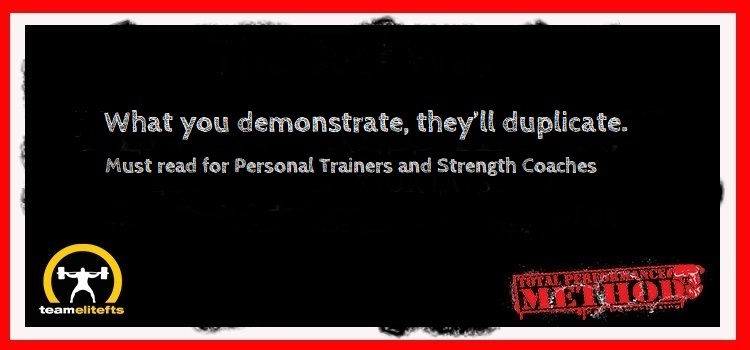
In today’s log, I will explain something I tell me TEAM when we are doing staff development; What you demonstrate, they’ll duplicate. I can’t say that I came up with that nugget of wisdom, but I never heard anyone else say it. So, I’m taking credit for it.
Let’s dig right into what it means.
As coaches, personal trainers or instructors of any type, we should be using the tell, show, do model of teaching. It really works well because it addresses all of the learning pathways you are going to encounter.
Let me explain the learning pathways quickly:
- Auditory Learners: these people need to hear you explain it
- Visual Learners: these people need to see it (some say this is 65% of the population or more)
- Kinesthetic Learners: thee people need to actually learn by doing
With that out of the way, the tell, show, do model covers all of your bases.
A great coach, or instructor will clearly and concisely explain what is about to be done. This assists the Auditory learner.
The coach will then will show what is to be done, and they must show it executed perfectly. The Visual learners get help here.
The final step is to have them do it, and do it as good as they can. This is the Kinesthetic learner.
Going back to What you demonstrate, they’ll duplicate:
If you show it wrong, the students will do it wrong. Your form and technique must be stellar. Think about it, if you show something done poorly or not as you described, how are your students or clients supposed to know what you showed them was wrong?
I’ll give you a few examples.
In my group program the TPS Method, we have a standard technique used for 7 exercises. We do this so that we have a repeatable customer experience. That means that all of the clients get the same technique shown regardless of who is the coach. A repeatable customer experience leads to better learning and less frustration. If all of the coaches show the same thing, all of the clients learn the proper technique.
I’ll use the Kettlebell Swing as an example here.
There are many ways to properly do swings depending on what variation you choose. If one coach is using a CrossFit style swing where the arms come up almost overhead, and the next one does a hard style swing and a third uses a Girevoy Sport style, the client is seeing three different, and perfectly acceptable styles of swing, BUT they are also getting confusing corrections on technique because Coach A said one thing, Coach B said do it a different way and Coach C told them something else. We all must demonstrate the same thing in group setting with multiple coaches.
Sticking with the swing as an example, I had a coach who used to prefer a different style swing in his own training than the one we use.

We use a swing technique with the feet at about hip width. The coach I am referring to did a more Sumo style swing in his own training, again, a perfectly acceptable thing to do, but just not here.
He would demonstrate the swing with a VERY wide stance and then have to correct people to do it from a closer stance.
But, they we doing what he demonstrated.
Remember, What you demonstrate, they’ll duplicate.
What if you cannot demonstrate the technique flawlessly?
Well, if you do not have the skill to do it, you probably should not be coaching it.
But let’s use me as an example or many old martial arts teachers. I cannot physically do a lot of even basic movements due to mobility issues and injury. I also found this in martial arts as well. The instructors were beat up from years of abuse and many could not still do the technique to the level they needed to for demonstration purposes. But they were very qualified to teach it.
I stole a play from their book, and I use a senior “student” or client who has excellent technique to demonstrate. This works well in a group setting but what about in one on one where no one else is available?
For me, I will usually explain a little more and then demonstrate a portion of the movement while letting them know that the visual is not 100% accurate and why. In this case, you verbal skills really need to be above average to coach someone to a high level.
I have also found that giving small visual cues works wonders. That is a topic for another log.
Summing up What you demonstrate, they’ll duplicate, use the tell, show, do model to address all learning pathways. As you demonstrate, make sure that you are showing them exactly what you expect done!
By doing this you will excel as a coach, personal trainer or instructor in any field. Make sure your technique is perfect!
Did you miss last week’s log?
Read it here.
SHARE THIS!
#bostonsstrongest
Vincere vel mori
C.J. Murphy
November 17, 2022









